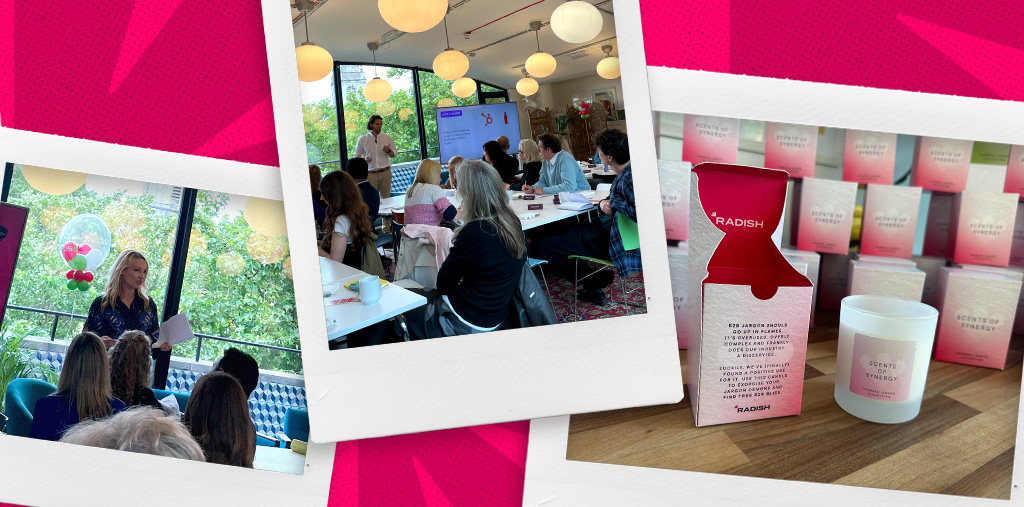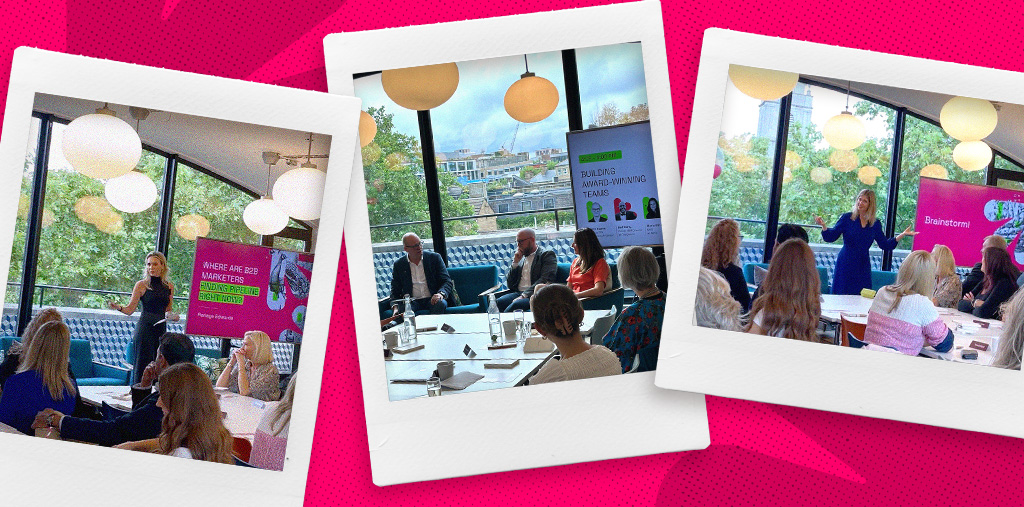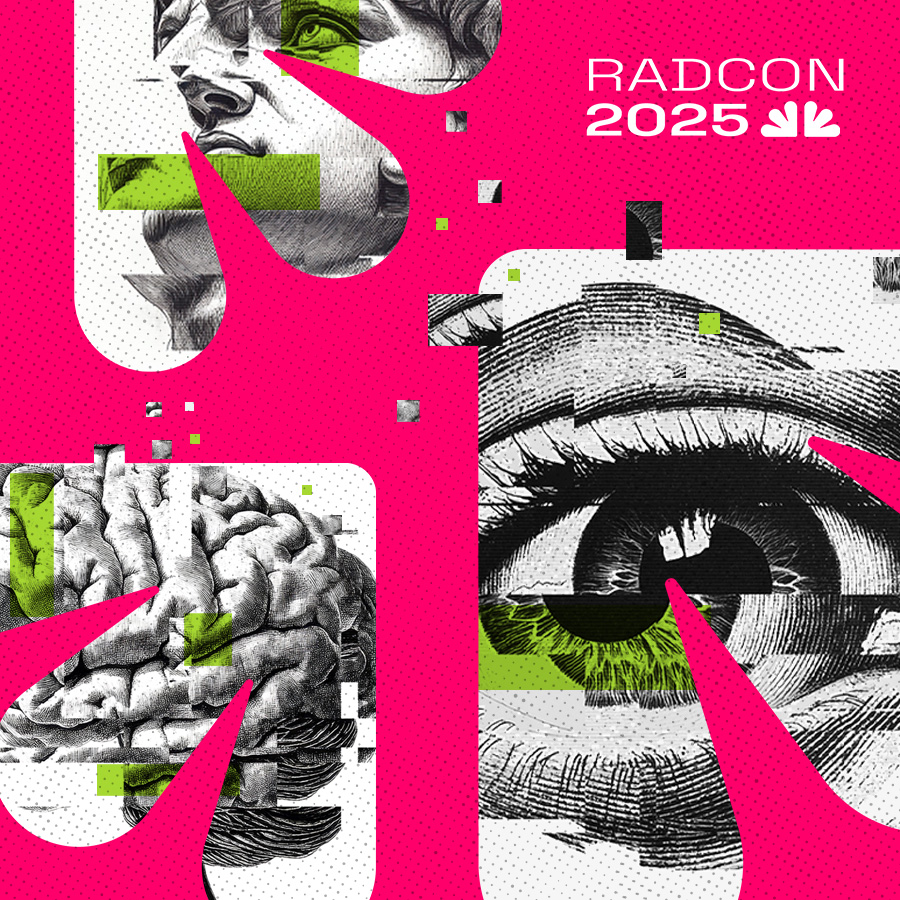Earlier this month, one of the standout days of the Radish calendar took place – RadCon. In a sea of fast-paced work, constant creativity and client needs, it can be hard to find the time to take a breath and come together as an agency.
RadCon is just that. For one day, the entire agency clears the calendar and comes together as a collective to reflect, share and learn from one another. And eat pizza.
With a full day of ideas and inspiration on the future of B2B marketing, each year we come away eager to put innovations and industry-rattling ideas into practice.
So on that note, here are seven things marketers can take from our inspirational event to stand against bland.
Where differentiation fails, distinctiveness works
What did we discuss? Head of Strategy Chris Willock’s session was all about tough love: 4 harsh truths for B2B brands. Chris focused on the sometimes painful truths that can be tough for B2B marketers to hear, but can drive them in the right direction.
One key takeaway: Only 5% of brands are considered unique by consumers.
What you can do: With development cycles shortening and USPs quickly being replicated, the Von Restorff effect (when multiple similar items are presented, the one that differs from the rest is more likely to be remembered) can make more of an impact. Brands should focus on creating distinctiveness through their tone of voice, visual identity, content and the channels they use for a far stronger chance of staying in their audiences’ minds.
Automate the foundations, hand-paint the finishes
What did we discuss? Lorna Charlish, our Managing Director and Co-Founder, looked at the big questions of AI and how modern work stands on the precipice of a new era, defined by these technologies and their capabilities.
One key takeaway: The two industrial revolutions, the digital information era, and the connectivity evolution of the 2010s, have each brought fundamental changes to how we work, and even reduced the number of hours in the working week. The era of AI is set to again fundamentally alter how jobs are defined as it matures.
What you can do: AI should be used as a tool to create the space and time to focus on creative work. AI has the ability to deliver ‘good’ foundations for work – but ‘good’ shouldn’t be the aim of any marketer looking to move the needle. AI tools work best to automate processes and put in place the raw materials a project is based on, but the truly original and creative work that drives value still has to take priority, and be handcrafted to reach ‘exceptional’.

Big stories don’t need big budgets
What did we discuss? Izabella Hannah-Maree, our Head of Content, turned our attention to the box office, for key lessons brands can use to entertain their audiences on social media from the movies. The session was titled ‘Are you not entertained?’ and, to be clear, we were.
One key takeaway: Powerful stories aren’t bound by big budgets (we don’t think $250 million-grossing The Blair Witch Project felt they should have upped their $60,000 budget). When it comes to designing social campaigns, lo-fi can work to your advantage.
What you can do: Take a look at the award-winning social media creative from UpWork, achieved using little more than a phone, a handful of everyday items, and some seriously committed employees.
Emotion and vulnerability multiplies B2B’s impact
What did we discuss? Sarah Purvis, our Creative Director, in her timeless fashion threw a curveball with ‘Unexpected lessons in creativity from the hairdressers’. Many said it was a trim, layered session.
One key takeaway: 60% of UK audiences reported feeling ‘nothing’ when faced with B2B ads, and these neutral campaigns need approximately ten times the spend of an emotion-led ad to deliver the same results.
What you can do: Creative inspiration can be found almost anywhere, and oftentimes the more left-field the source, the more that can be learnt from it. Being vulnerable – much like when getting your hair cut – can make a huge difference when creating memorable campaigns. B2B needs to let its walls down, and lead with people, feelings and empathy to stay in audiences’ minds.

Make an entrance (and make brand the leading lady)
What did we discuss? Senior Strategist Elspeth Webster made a compelling case that B2B needs to be more of a diva, taking cues from some of the world’s most famous examples.
One key takeaway: Sashaying to the front of mind from the presentation was the tiny sliver of attention that B2B ads are fighting for – on average, 3.7 seconds for videos on LinkedIn.
What you can do: Visual content needs to foreground the important things, capturing audiences’ attention as early as possible to have the best chance of succeeding. And with brand recognition a big part of this type of content, a brand needs to be represented at least three times in the first ten seconds of your content to stick in peoples’ minds.
Use human relatability to create links with your audience
What did we discuss? Senior Account Manager Liv Liston-Smith focused on the viral Netflix hit of the year, Adolescence, and what could be learned from the gripping drama.
One key takeaway: The basis of the session’s focus was neuro-coupling: the way that great content, steeped in relatable human emotion, can drive audiences to feel the same way.
What you can do: Rewatch the initial, pulse-pounding police raid that kicks off the series, and ask yourself what you felt watching it. Chances are, it would be anxiety, fear and confusion as you’re sucked in to such a degree, you feel the emotions of the characters on screen. This is a timely reminder that sometimes it benefits brands to leave the features in the background, and focus on the human emotions that they inspire.
Embrace the unconventional – but don’t force it
What did we discuss? Jack Toop, our Senior Creative Copywriter, focused on a staple of Radish creativity – being weird.
One key takeaway: Jack reminded us that even the most unconventional work needs to adhere to some core rules that make weird work. There were three to keep in mind:
- Unconventional ideas make no sense without links back to the product
- Don’t copy someone else’s weird
- Knowing you’re weird makes your ideas self-aware – and grating
What you can do: Remember the rule coined by Jason Bagley, that marketers should aim to ‘push it to the edge of madness’. Start big, start wild, and then go from there; safe ideas rarely are remembered.
Time to turn inspiration into action
And it was there that RadCon 2025 ended. Well, the work bit did, as we hastily grabbed the remaining pizza slices and began plotting our route to the pub.
To discuss the lessons above, or for a wider chat about your marketing and brand needs, you can reach us here.


 Selbey Anderson Group of agencies
Selbey Anderson Group of agencies